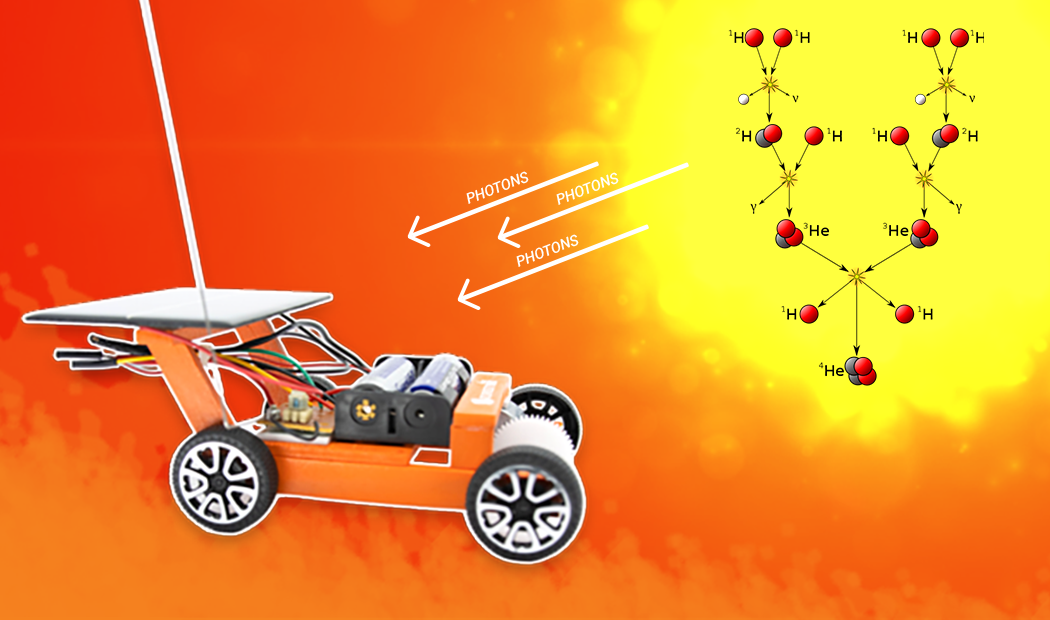
The solar panel that drives your car is bleeding-edge 19th century electrical engineering technology. That’s right - the first solar cell was built way back in 1883 by Charles Fritts, a New York inventor. That’s before the automobile, which was invented two years later by Karl Benz. Of course, it took almost a century for the two technologies to be married together: the first solar “car” was about the same size as the car in your kit, a 38 centimeter long model built in 1955 by GM engineer William Cobb. And the first full-scale, long-distance solar car was 1982’s Quiet Achiever, which drove all the way across Australia on nothing but solar power.
Solar panels work through a fascinating process that starts in the heart of the Sun. It begins with a proton-proton nuclear fusion process which releases energy that travels from the core and out into the solar system. And creating that energy involves a lot of protons, as you might expect: 9.2 x 1037 (92,000,000,000,000,000,000,000,000,000,000,000,000) every second! Only.7% of that mass is actually turned into energy (think E=mc2), but that still comes out to 4.26 million metric tonnes of mass each second, generating energy that then travels across the solar system – it’s the biggest fusion reaction within 40 trillion kilometers.
And when that energy strikes the solar panel of your car, it’s the Photovoltaic Effect that transforms the sun’s light into electricity that powers the car’s motor. Speaking of E=mc2, it was Albert Einstein himself who was instrumental in understanding how that works; in fact, his Nobel Prize was “for his services to Theoretical Physics, and especially for his discovery of the law of the photoelectric effect” – not for the Theory of Relativity! In his own time, Einstein was much better known for his explanation of photovoltaics.
So how do solar panels work? The energy from the Sun is transmitted to your car via photons (Einstein called them “light quanta”) – which we tend to experience as visible light. When photons with energy above a certain threshold hit the metal surface of the solar cell, they each collide with an electron and knock it loose; it then becomes a free-roaming negatively charged particle called a photoelectron. Once you’ve got a flow of electrons – well, that’s literally the definition of electricity – then the charge flows into the car’s motor and awaaaaaaay you go!
The amount of light that’s turned into electricity by a solar cell is called its “conversion efficiency.” Fritts’ 1883 cell had a 1% conversion efficiency; most modern cells like yours have a CE between 15-20%. For comparison, the conversion of gasoline into energy in an automobile engine operates at around 30% CE, and the general conversion efficiency for photosynthesis, the other major solar-power energy source, is 3% (though some overachieving plants can make it all the way up to 4.6%). The maximum possible efficiency of a solar cell, BTW, is 33.7%, and it’s called the Shockley–Queisser limit. But by layering cells that react to different wavelengths, you can get around that. The maximum conversion efficiency achieved with these tandem cells is 47.1%, a feat that happened just 5 months ago.
Your car is part of a growing trend towards photovoltaic electricity; it currently accounts for 1.8% of power generated in the US, 8% in Germany, Australia, and Israel, and a whopping 14% in Honduras. With the 2021 release of LightYear One, the first solar-powered production car, soon you may even have more than one solar car in the garage!

